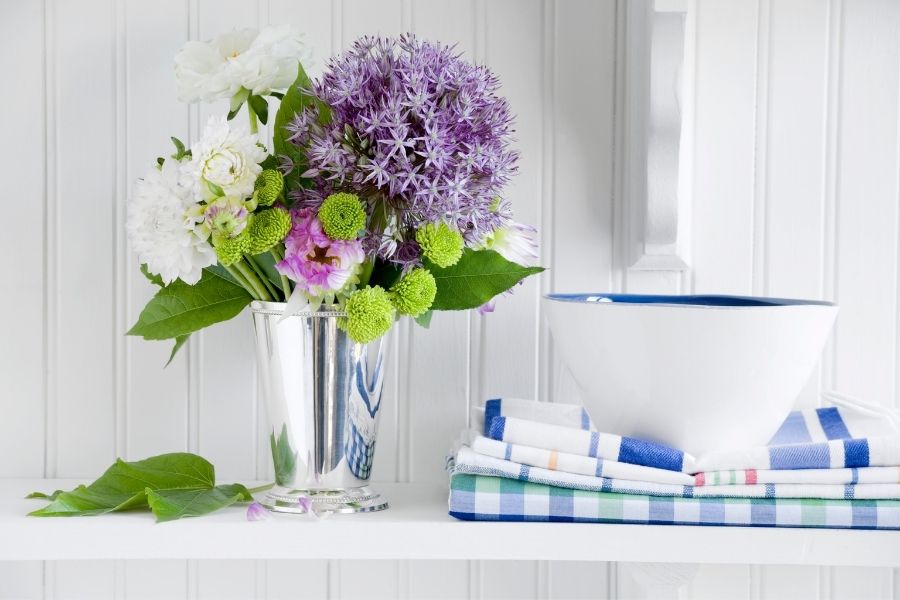Bringing Order to Our Homes
“When life gets too cluttered, we neglect the important things.”
~ Emilie Barnes
Bringing Order to Our Homes:
I love to work in an orderly workspace. I love order and beauty in my home. Studies have proven that people think clearer and better in uncluttered environments. When I finish cleaning a room or my whole house I love to just take a moment to sit with a cup of tea and a good book and enjoy the order.
Clutter is a real enemy. Clutter can keep us from enjoying our families and homes as it takes up our time, can rob us of our joy, can add stress to our lives, and takes up our living space.
Our homes all have different personalities because we are all different so order for one person will look different for the next person. There are some simple questions we can all ask as we desire to bring order to our homes. What is important to you? What activities take place in your home? How would you like your immediate family to think about or even remember your home? These are some good starts for real change to start in your battle to conquer your clutter.
What is the Purpose of Your Home:
We already stated that our homes are all different because we all have different values and priorities. One of the first steps to decluttering is to determine the purpose and use of your spaces in your home. The hope is your home will serve you and your family well instead of you serving your home. If it is uncluttered and there is a purpose to each room it will be much easier to clean and keep order.
I have found I need to determine what the purpose is for each room before I can begin to declutter. It is a simple step that seems to get neglected in most decluttering books.
Take the time to spend a few moments in each room of your house with a pen and paper in hand and write out what happens in each room. What is the room’s purpose and what activities take place in that room? There are probably going to be one, or two at most, purposes for each room in your home.
An example would be your kitchen. In my kitchen, we eat and fellowship around the table. In your kitchen, you may do meals and homeschool so you’re going to be dealing with how to design your kitchen around those two purposes. In our family room, we read, watch television, DVD’s and play games so my room is designed around those purposes (more than one purpose but similar). In our bedrooms, we sleep and read. I’m hoping you’re catching on to this ;).
A Place for Everything:
If you get one thing from this post catch this one: there must be a place for everything to maintain order in your home. The moment an item in my home doesn’t have a home is the start of clutter (and it doesn’t take long for clutter to build from there).
If everything has a place it makes it easier for you and your family to clean up. You save time by not losing items and spending time looking for them. The things you need are in the right place where you use them.
Related Podcast: EP 14 Simple Tips to a Clutter-Free Home
Put items where you find yourself using them and where they are most convenient. It sounds simple but many of us don’t do this. A big clutter area we all seem to have is where we enter and exit our homes. Make sure you have good storage in that area of your home. A place for shoes, coats, keys, bags, etc.
Again, take it a room at a time and envision how you use that room and what you need to find homes for in each room.
Identifying the Clutter:
The clutter in our homes begins little by little over time. It doesn’t happen overnight and it’s not fixed in a day. We need to get to the underlying reasons for our clutter. Much of our clutter is holding on to items that we are emotionally attached to. I’m less likely to get rid of an item if I’m emotionally attached to it. The reality is I can’t keep every memory of my children’s childhood. I need to determine which items I’m going to keep and how I’m going to store them (photos of them with an item, several items kept from each year of school or journal for each school year are some ideas to cut down on children’s paperwork clutter).
Paperwork is usually one of the big clutter areas to battle. Have a system for your daily mail so it doesn’t gather into a pile on your counter. Try to keep papers from coming into your home. Write appointments right into your calendar and don’t take the little reminder card. If you’re comfortable do most of your banking and bill paying online. (See my Simple Home Filing System.)
Clutter is best defined as anything you have in your home that doesn’t have a purpose. Ask yourself what the benefit is of holding on to this item. The other area you need to consider is the amount of space you have available in your home for storage.
Eliminating Clutter:
So you’ve determined the purpose of each room at this point and are pondering ways to get a hold on your paperwork clutter. You are now ready to start tearing it apart room by room so where do you start?
Remember, you can’t organize clutter. So we need to get our three bags or boxes and label them:
- Throw Away
- Give Away
- Put Away
Give Away is for items to donate. Put away are for items whose purpose is not in the current room you are decluttering but need to find another spot where they are more conveniently used. The biggest bag you will probably have is throw away. This one is obvious ;).
I encourage you to start small with drawers and cupboards and leave larger closets for last. Just these small starts can encourage you to press on to the larger areas. After you have determined the purpose of the room and decluttered, you can start to see if there are any storage needs that would help make it more productive and easy to clean up.
My best advice is to do a little a time and set a timer to work in that room 15-30 minutes a day until it’s finished before you move to the next room. (See my Homemaking 101 Series here on Decluttering your home one room at a time.)
Please know that this will be a continuing pattern of your life. We never declutter once in our lives and it’s over. It is a continuous cycle that will be part of our lives while on this earth. Clutter really will be dealt with daily. Some of us naturally deal with clutter and others of us (me included) really need to work at it. I have to work hard at staying organized, it is not natural for me but I love the benefits of having a home with order and not chaos.
Benefits of Decluttering:
There are many benefits to decluttering but I think the big one is time saved. When my home is decluttered and tidy I spend much less time cleaning and when I do clean it is extremely simplified. My mind is freed up because I know where to find needed items, especially important papers. I have more time to spend with my family and less time to spend cleaning and organizing.
“If you want to make room in your life for peace and patience, take small steps on organization, know the value of time. Snatch, seize and enjoy every minute of it!”
~Emilie Barnes


